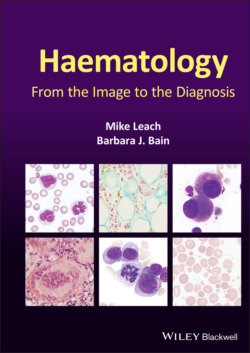Читать книгу Haematology - Barbara J. Bain, Irene Roberts - Страница 28
Оглавление19 Essential thrombocythaemia
A 40‐year‐old man was referred on account of a persisting thrombocytosis. He was a smoker but gave no other past medical history of note and physical examination was unremarkable. The full blood count showed Hb 144 g/l, WBC 6.7 × 109/l, neutrophils 3.5 × 109/l and platelets 621 × 109/l. Serum ferritin was 120 μg/l. He had normal serum biochemistry and the ESR and CRP were normal. The blood film showed mild platelet anisocytosis but no other abnormality. The working diagnosis was essential thrombocythaemia (ET) but mutations in JAK2 and MPL genes and deletions in CALR gene were not identified. The bone marrow trephine biopsy sections were mildly hypercellular (60%) and showed increased numbers of megakaryocytes forming clusters (left images, H&E, centre images, immunoperoxidase for CD42b) (all images ×50 objective). The megakaryocyte morphology was largely normal but some larger forms were recognised (lower centre image). There was some mild focal increase in reticulin staining (grade 1 of 3, right images). Erythroid and myeloid activity were normal and no abnormal infiltrate was noted. A diagnosis of ET was made.
Essential thrombocythaemia is a myeloproliferative neoplasm characterised by persistent thrombocytosis in the absence of anaemia or polycythaemia. Around 85% of cases will show abnormalities in JAK2, CALR or MPL but so called ‘triple‐negative’ cases do exist (Cazzola and Kralovics 2014). In such circumstances the diagnosis is one of exclusion when persistence of thrombocytosis is shown, reactive causes are excluded and the bone marrow morphology supports the diagnosis and excludes other myeloproliferative neoplasms (polycythaemia vera, primary myelofibrosis and chronic myeloid leukaemia). Bone marrow trephine biopsy sections typically show only mild hypercellularity, an increase in medium to large megakaryocytes with focal aggregations or ‘clustering’ with only a minimal, if any, increase in reticulin staining. A cluster requires three or more megakaryocytes to be adjacent to, or touching, each other. Cases that are suspicious for ET, but without sufficient features for a definitive diagnosis, are not uncommon. A proportion of these triple‐negative cases show either a low allele burden, an alternative mutation site in JAK2 or MPL or a mutation only identified by examining platelet RNA (Angona et al. 2016), but evidence of clonality is currently not demonstrable in all cases that appear to be true ET.
References
1 Angona A, Fernández‐Rodríguez C, Alvarez‐Larrán A, Camacho L, Longarón R, Torres E et al. (2016) Molecular characterisation of triple negative essential thrombocythaemia patients by platelet analysis and targeted sequencing. Blood Cancer J, 6, e463.
2 Cazzola M and Kralovics R (2014) From Janus kinase 2 to calreticulin: the clinically relevant genomic landscape of myeloproliferative neoplasms. Blood, 123, 3714–3719.
MCQ
1 Essential thrombocythaemia:Causes itch in a minority of patientsIs associated with JAK2 V617F in more than half of patientsIs most often an incidental diagnosis in an asymptomatic patientIs Ph+, BCR‐ABL1+ in only a minority of patientsTypically has small plateletsFor answers and discussion, see page 206.
